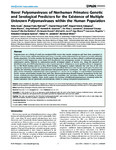Novel Polyomaviruses of Nonhuman Primates: Genetic and Serological Predictors for the Existence of Multiple Unknown Polyomaviruses within the Human Population
| dc.contributor.author | Scuda, N | |
| dc.contributor.author | Madinda, NF | |
| dc.contributor.author | Akoua-Koffi, C | |
| dc.contributor.author | Adjogoua, EV | |
| dc.contributor.author | Wevers, D | |
| dc.contributor.author | Hofmann, J | |
| dc.contributor.author | Cameron, KN | |
| dc.contributor.author | Leendertz, SAJ | |
| dc.contributor.author | Couacy-Hymann, E | |
| dc.contributor.author | Robbins, M | |
| dc.contributor.author | Boesch, C | |
| dc.contributor.author | Jarvis, MA | |
| dc.contributor.author | Moens, U | |
| dc.contributor.author | Mugisha, L | |
| dc.contributor.author | Calvignac-Spencer, S | |
| dc.contributor.author | Leendertz, FH | |
| dc.contributor.author | Ehlers, B | |
| dc.date.accessioned | 2015-07-17T07:57:21Z | |
| dc.date.available | 2015-07-17T07:57:21Z | |
| dc.date.issued | 2013 | |
| dc.identifier.issn | 1553-7366 | |
| dc.identifier.issn | 1553-7374 | |
| dc.identifier.other | ARTN e1003429 | |
| dc.identifier.uri | http://hdl.handle.net/10026.1/3435 | |
| dc.description.abstract |
Polyomaviruses are a family of small non-enveloped DNA viruses that encode oncogenes and have been associated, to greater or lesser extent, with human disease and cancer. Currently, twelve polyomaviruses are known to circulate within the human population. To further examine the diversity of human polyomaviruses, we have utilized a combinatorial approach comprised of initial degenerate primer-based PCR identification and phylogenetic analysis of nonhuman primate (NHP) polyomavirus species, followed by polyomavirus-specific serological analysis of human sera. Using this approach we identified twenty novel NHP polyomaviruses: nine in great apes (six in chimpanzees, two in gorillas and one in orangutan), five in Old World monkeys and six in New World monkeys. Phylogenetic analysis indicated that only four of the nine chimpanzee polyomaviruses (six novel and three previously identified) had known close human counterparts. To determine whether the remaining chimpanzee polyomaviruses had potential human counterparts, the major viral capsid proteins (VP1) of four chimpanzee polyomaviruses were expressed in E. coli for use as antigens in enzyme-linked immunoassay (ELISA). Human serum/plasma samples from both Côte d'Ivoire and Germany showed frequent seropositivity for the four viruses. Antibody pre-adsorption-based ELISA excluded the possibility that reactivities resulted from binding to known human polyomaviruses. Together, these results support the existence of additional polyomaviruses circulating within the human population that are genetically and serologically related to existing chimpanzee polyomaviruses. | |
| dc.format.extent | e1003429-e1003429 | |
| dc.format.medium | Print-Electronic | |
| dc.language | en | |
| dc.language.iso | eng | |
| dc.publisher | Public Library of Science (PLoS) | |
| dc.subject | Animals | |
| dc.subject | Antibodies, Viral | |
| dc.subject | Capsid Proteins | |
| dc.subject | Enzyme-Linked Immunosorbent Assay | |
| dc.subject | Female | |
| dc.subject | Humans | |
| dc.subject | Male | |
| dc.subject | Monkey Diseases | |
| dc.subject | Phylogeny | |
| dc.subject | Platyrrhini | |
| dc.subject | Polyomavirus | |
| dc.subject | Polyomavirus Infections | |
| dc.title | Novel Polyomaviruses of Nonhuman Primates: Genetic and Serological Predictors for the Existence of Multiple Unknown Polyomaviruses within the Human Population | |
| dc.type | journal-article | |
| dc.type | Article | |
| plymouth.author-url | https://www.ncbi.nlm.nih.gov/pubmed/23818846 | |
| plymouth.issue | 6 | |
| plymouth.volume | 9 | |
| plymouth.publication-status | Published online | |
| plymouth.journal | PLoS Pathogens | |
| dc.identifier.doi | 10.1371/journal.ppat.1003429 | |
| plymouth.organisational-group | /Plymouth | |
| plymouth.organisational-group | /Plymouth/Faculty of Health | |
| plymouth.organisational-group | /Plymouth/Faculty of Health/School of Biomedical Sciences | |
| plymouth.organisational-group | /Plymouth/REF 2021 Researchers by UoA | |
| plymouth.organisational-group | /Plymouth/REF 2021 Researchers by UoA/UoA01 Clinical Medicine | |
| plymouth.organisational-group | /Plymouth/Research Groups | |
| plymouth.organisational-group | /Plymouth/Research Groups/Institute of Translational and Stratified Medicine (ITSMED) | |
| plymouth.organisational-group | /Plymouth/Research Groups/Institute of Translational and Stratified Medicine (ITSMED)/CBR | |
| plymouth.organisational-group | /Plymouth/Users by role | |
| plymouth.organisational-group | /Plymouth/Users by role/Academics | |
| dc.publisher.place | United States | |
| dcterms.dateAccepted | 2013-05-01 | |
| dc.identifier.eissn | 1553-7374 | |
| dc.rights.embargoperiod | Not known | |
| rioxxterms.versionofrecord | 10.1371/journal.ppat.1003429 | |
| rioxxterms.licenseref.uri | http://www.rioxx.net/licenses/all-rights-reserved | |
| rioxxterms.licenseref.startdate | 2013 | |
| rioxxterms.type | Journal Article/Review |


